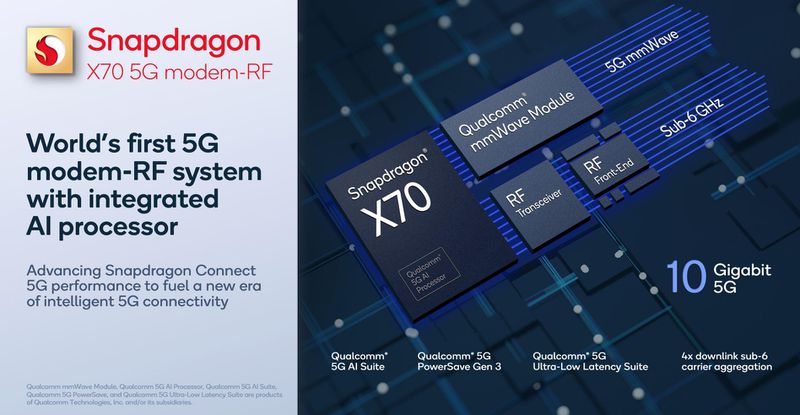iFixit has uncovered the 5G modem chip in iPhone 15, revealing that it’s a Qualcomm modem, just like the one used in the iPhone 15 Pro.
Shahram Mokhtari, the Lead Teardown Technician at iFixit, shared a photo of the iPhone 15’s motherboard on his Twitter account. The photo clearly shows that the iPhone 15 employs the Qualcomm Snapdragon X70 modem, mirroring the setup in the iPhone 15 Pro.
What’s intriguing about this discovery? Both the iPhone 15 and 15 Plus employ a system-on-a-chip (SoC) architecture, similar to the iPhone 14 Pro, which features the Apple A16 Bionic chip. However, the iPhone 14 Pro uses the older X65 modem with its A16 Bionic chip, while in the iPhone 15, the A16 Bionic is paired with the X70 modem. On the other hand, the iPhone 15 Pro utilizes the A17 Pro chip paired with the X70 modem.
Apple didn’t Just Transplant the iPhone 14 Pro’s Motherboard
In essence, Apple didn’t just transplant the iPhone 14 Pro’s motherboard into the iPhone 15; they made several alterations to the motherboard. The X70 modem promises greater power efficiency compared to the X65, and it’s equipped with an AI processor to enhance its performance.
Court documents that came to light in 2020 during the Apple-Qualcomm legal showdown revealed the initial plan was to use a combination of X65 and X70 modems for iPhones in 2022 and 2023, which were expected to be the final Qualcomm modems used in iPhones.
Apple and Qualcomm Later Extended their Agreement until 2026
However, Apple and Qualcomm later extended their agreement until 2026 because Apple hadn’t been able to develop its own 5G modem. Apple has long sought to reduce its reliance on Qualcomm. In 2017, they sued Qualcomm due to excessive licensing fees. The lawsuit was settled in 2019, and Apple promptly acquired Intel’s modem business, including its thousands of engineers, to expedite the development of Apple’s 5G modem.
Nonetheless, Apple seems to have underestimated the complexity of this development process. The reality is that it’s a challenging task, and Apple’s in-house modem prototypes consistently fell short of expectations, with notably slow speeds.
“Essentially three years behind the best Qualcomm modem chips,” wrote The Wall Street Journal in its report.
The Qualcomm Connection in iPhone 15
The revelation that the iPhone 15 employs Qualcomm’s Snapdragon X70 modem is noteworthy for several reasons. Qualcomm is a well-established player in the semiconductor industry, specializing in wireless communication technologies. The Snapdragon X70 is Qualcomm’s flagship 5G modem, promising impressive capabilities in terms of both power efficiency and performance.
Apple’s decision to utilize Qualcomm’s modem chips, even though they have been working on their in-house modems, showcases the formidable technology that Qualcomm has brought to the table. Apple’s journey to develop its modem started with the acquisition of Intel’s modem business in 2019. This acquisition included a wealth of talent and intellectual property that was intended to accelerate Apple’s efforts to create its 5G modem.
However, the process of developing a 5G modem that could meet Apple’s stringent standards has proven to be more challenging than anticipated. Apple’s prototypes continually underperformed, both in terms of expected speed and overall capability, which led to Apple extending its agreement with Qualcomm to use the Snapdragon X70 modem.
The Need for In-House Modem Development
Apple’s drive to develop its modem was grounded in the desire for greater control over its products and less reliance on external suppliers.
Achieving this would not only allow Apple to reduce its reliance on Qualcomm, but it would also provide them with more influence over their devices’ performance and capabilities. Apple has a history of designing its own chips for iPhones and other devices, which has contributed to its reputation for producing high-performance products.
Conclusion
In conclusion, the discovery that the iPhone 15 uses Qualcomm’s Snapdragon X70 modem reinforces the significance of strong partnerships in the tech industry. Despite Apple’s efforts to develop in-house modems, Qualcomm’s expertise and technology remain integral to delivering high-quality wireless capabilities in Apple’s flagship smartphones. As technology continues to advance, partnerships between tech giants may be more common than ever, reinforcing the notion that collaboration can drive innovation.


